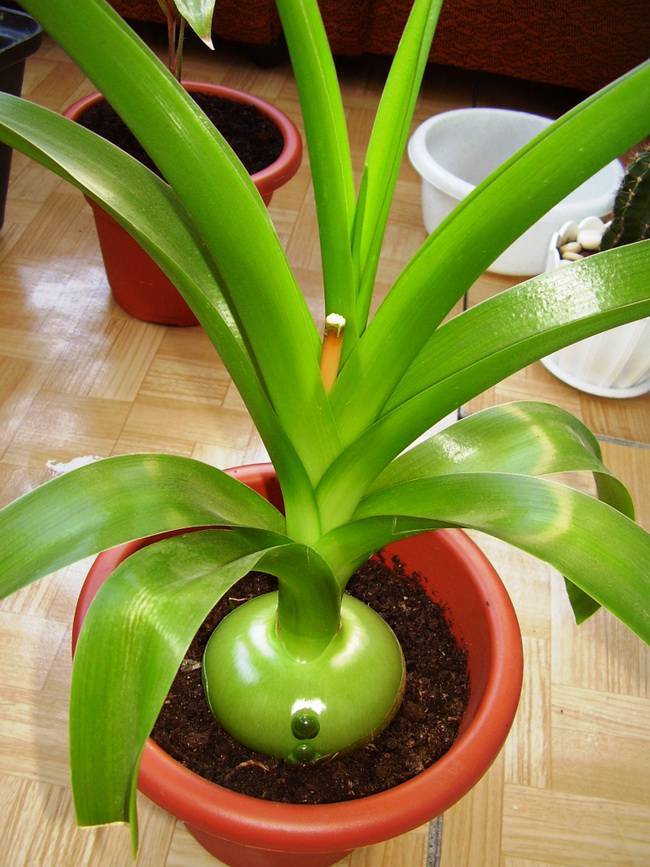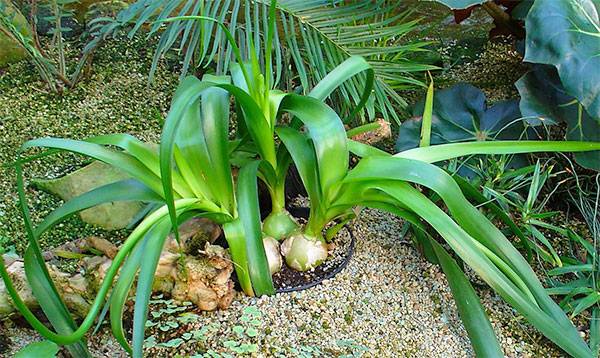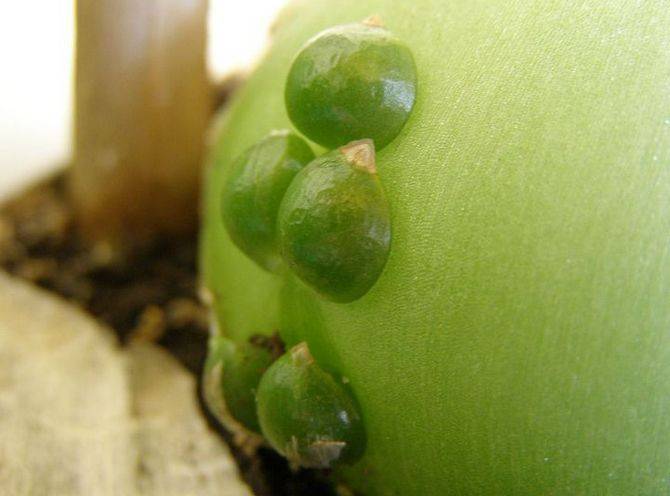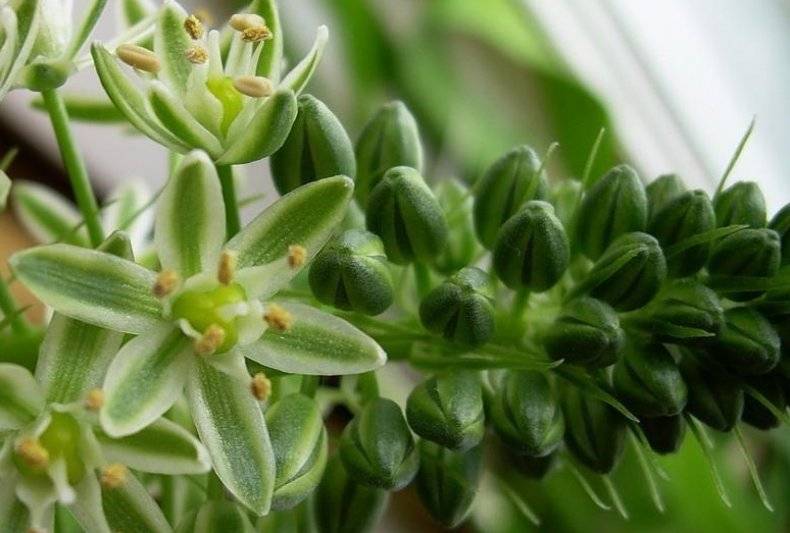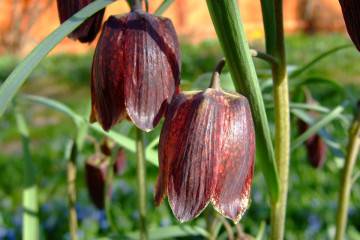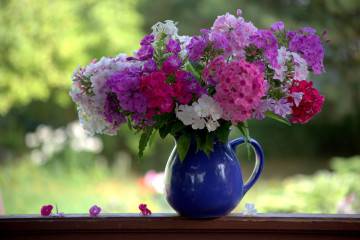Indian bow - what is it, what it looks like
Content:
Indian onions are familiar not only to flower growers. People who suffer from recurrent back and joint pains know about its medicinal properties. Onion-based tinctures are used to relieve various types of pain on the surface of the body. The unpretentiousness and decorativeness of the flower allow everyone to acquire this exotic.
Indian bow - what is it, what it looks like
Unusual green bulb from which wide, belt-like leaves grow. The length of the sheet can be up to a meter, twisting at the end. The bulb grows above the ground, covered with dry scales. And two years later, an adult specimen will begin to grow overgrown with children.
Use in traditional medicine
The flower is bred not only as an ornamental plant, but also as a home doctor. You just need to wait until the plant is two years old in order to use it for treatment.
The juice from the leaves, as well as the tincture from the onion, have analgesic and healing properties:
- Prescription alcoholic tinctures from grandmothers are used for toothache, headache and joint pain.
- The tincture relieves pain in osteochondrosis, radiculitis, arthritis, neuralgia.
- The juice of the leaves is used for insect bites, bruises, bruising and open wounds as an antiseptic and to relieve pain.
The ability to improve blood flow to the area treated with onion tincture relieves swelling. Also, onion juice is used to treat varicose veins, papillomas, warts and other neoplasms.
In addition to its medicinal properties, the plant disinfects the air in the room where it grows.
Decorativeness of the plant
The exotic South African is actively growing green mass throughout the year. Its succulent wide leaves deserve attention from florists.
Even damaged leaves continue to grow without losing color or drying out. The leaves grow densely, new shoots constantly appear on one bulb. The light green onion looks unusual and bright against the background of other flowers.
The bloom is also green and showy. The older the flower, the larger the tassel and the number of flowers.
How to plant an Indian onion correctly
To change the soil and place of growth, the flower responds positively. Grows in any soil, provided there is good drainage at the bottom of the pot. A wonderful combination for full-fledged growth would be a mixture of:
- turf land;
- leafy soil;
- charcoal;
- sand.
When planting a small onion, it only needs to be immersed in the soil halfway. An adult plant is planted in the ground only with its roots, the entire bulb remains on the surface.
In the garden, it is easy to care for Indian onions, as well as for indoor ones. Needs moderate watering and good lighting. It will grow remarkably and gain strength during the warm period. The roots of the plant can go a meter deep, it is important to take this into account when transplanting back into the pot.In order not to tear off the roots from the base, you should dig up the plant, shaking off the roots from the ground and cut off the excess from below.
Houseplant care at home
Growing Indian onions at home is not troublesome. Heat-loving exot is not too demanding in terms of care. It can withstand drought for up to 60 days. The main thing for him is good lighting and moderate watering.
Illumination and temperature conditions
An African guest loves warmth, when the temperature drops below 12 ° C, it stops growing and goes into hibernation. This move is used by gardeners when breeding onions in the flower beds of the garden. In winter, the bulbs sleep at a temperature of +5 ° C. For indoor residents, the usual temperature of the house is acceptable.
But there are requirements for lighting. Luscious greenery requires placement on the eastern and southern windowsills. In partial shade, the leaves may drop slightly and fade. When placed on a window, it should be protected from hot summer rays.
Watering rules and humidity
Watering needs regular. But underfilling is better than overfilling. The flower is very sensitive to excess moisture and may even die. In the summer, you need to water more often, but in moderation. In winter, you need to moisten the soil when the soil on top is completely dry.
But the poultry farm loves high humidity. The plant receives moisture from the air with its wide leaves, which thanks to its rich green color. Regular spraying of the flower and the air around it will promote vigorous and healthy growth.
Top dressing and soil quality
In a pot with an earth mixture, the onion quickly draws useful and nutritious elements from the soil. Regular fertilization supplies the plant with the necessary supply of nutrition.
Once every 2-3 weeks, fertilize with minerals and organic matter. Once a month, you can water with a weak solution of potassium permanganate or wood ash. The flower responds well to mullein feeding.
When planting in open ground for the summer period, the introduction of complementary foods is suspended.
Plant propagation methods
Raising an Indian onion baby is easy. The biennial plant is covered with small bulbs. They can be easily separated from the mother plant and rooted. Even if there are no roots on the onion, it will acquire them very quickly.
You can also grow from seeds. After flowering, seeds ripen in the seed pods, similar to those of ordinary onions. They are sown in a mixture of peat and sand and create mini-greenhouse conditions. Seed sprouts must be protected from direct sunlight and hypothermia.
In extreme cases, the bulb of an adult plant is cut in half. For this, the green part of the plant is completely cut off. The halves are planted in new pots with renewed soil. At first, development slows down, as the root system grows. But soon the leaves will begin to appear.
How to transplant Indian onions
Regular transplanting of a flower provokes its active growth and flowering. Onions love changing soil and expanding the pot.
During transplanting, it is important to increase the flower pot by 1.5-2 cm in diameter. This plant does not impose requirements on the material of the pot.
It is necessary to make several holes in the bottom of the pot and spread a drainage layer of at least 3 cm. Stagnant moisture in the pot causes rotting of the roots.
Features of flowering Indian onions
The flowering of the poultry farm does not look like the usual ball of ordinary onions. This exotic releases an "arrow" on which a tassel of small flowers is located. Six white petals of each flower are decorated with a light green stripe in the middle. In the center is a bunch of white stamens. At the end of flowering, seed pods are formed.
For an experienced florist and a beginner in the cultivation of indoor plants, this exotic will not cause unnecessary trouble. Moreover, regardless of the purpose for which the Indian onion was acquired by a florist.
